The word Geranium, scientifically speaking, is a genus of perennials commonly called cranesbill. The word geranium also commonly refers to a large group of annual geraniums scientifically known as Pelargoniums, Pronunciation: pe-lar-GO-nee-um. The 2 genera were originally grouped together taxonomically, but in 1789 they were divided into 2 separate genera. However, pelargoniums continue to be commonly called geraniums to this day and are the main subject of this article.
The genus geranium is hardier than pelargoniums, growing as perennials in zones 4 to 9. They contain about 300 species with a great deal of variation. Some grow in small delicate mounds like the popular Ballerina Cranesbill (Geranium cinereum ‘Ballerina’) with its lacy foliage and dainty pink flowers that have purple veining. Other species are larger and can get a bit floppy. Some make great ground covers like Bloody Cranesbill (Geranium sanguineum) that grows to about 23-30cm (9-12″) tall with magenta-pink flowers and citrusy fragrant leaves that turn blood red in the fall. Other species are grown predominantly for their flower colour like ‘Johnson’s Blue’ (Geranium ‘Johnson’s Blue’) which has the most beautiful lavender-blue coloured flowers held above medium sized mounds (about 45cm (18″)) of citrusy fragrant leaves.
Pelargoniums similarly have several species and over 200 hundred cultivars and hybrids. This list of Pelargoniums is commonly broken down into groups that share similar characteristics such as Species, Zonal Geraniums, Stellar, Fancy leaf geraniums, Scented-leaf, Ivy-Leaved, Interspecific, Regal, Angel, Rosebud geranium, and a few others, depending on who is categorizing them. Let’s take a look at some of these groups and their typical characteristics to help you decide which type is best suited to your garden needs.
Pelargonium Groups
Species Pelargonium
Species Pelargonium are able to grow naturally in the wild reproducing offspring identical to themselves. They are also potentially able to naturally cross pollenate in the wild with other Pelargonium species creating new species that will breed true from seed, meaning each seedling will look identical to one another and to its parent. They are native mostly to south Africa but there are some species from Australia, New Zealand, and a few other regions in zones 10-12. There is a great deal of variety to choose from with some species that have highly unusual flowers or foliage. In temperate zones like North America, they tend to be grown by hobbyists often in conservatories.
Zonal Geraniums
The majority of pelargoniums that gardeners grow are hybrids rather than species. The most popular hybrid is called Zonal Geraniums (Pelargonium × hortorum), a cross between the 2 Pelargonium species, Pelargonium inguinans and Pelargonium zonale, both natives of south Africa. This is the type of geranium you are most likely to find at garden centers. It is known for its large, round, colourful flower clusters (umbels) that are held on sturdy stems above a mound of often fragrant, roundish, velvety leaves with slightly ruffled edges. They get their common name from the darker coloured zone that often appears in a horseshoe shape, inside the leaf border. Zonal geranium are heat lovers and prefer full sun and to dry out slightly between waterings. They are also heavy feeders and require bi-weekly fertilizing. Even though zonal geraniums have several characteristics in common there is still plenty of variation between varieties and cultivars.
When choosing a zonal geranium some differences to look for include:
Size: which typically is about 35-40cm (14-16″) tall and wide but can range anywhere from 20-90cm (8″ to 36″). The overall size will affect its placement in the garden or the size of container you grow it in.
Bloom Colour: there are a lot of great colours out there to choose from, like dark red, orangey red, rose, light pink, mid-pink, dark pink, fushia, coral, salmon, orange, lavender, white and even bi-coloured flowers. Some cultivars and hybrids can also have speckled petals or may have an eye or a spot.

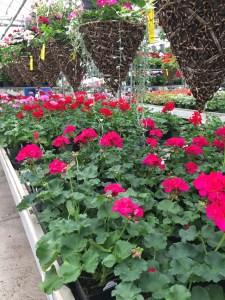

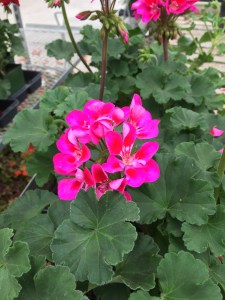
Other Bloom Variations: Zonal geraniums can have single 5 petaled flowers, semi-double or double petal counts that are clustered together in an umbel. The petals may open fully or be so full they only open partially, like the rosebud geraniums. There can also be variations in the petal shape with some cultivars having heart shaped petals, cup shaped, quill shaped or narrow petals with pointed ends. The overall size of the bloom can also vary between cultivars and hybrids as can the number of overall blooms.
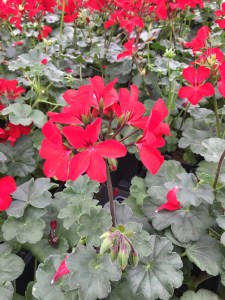

Leaf variation: some leaves have very distinct zonal markings while others are very subtle, even absent. Leaves can vary in colour from light green to dark green, they can be bi-coloured or tri-coloured and some cultivars have white leaf edges. The cultivars with the highly decorative leaves are usually placed in a group called Fancy Leaved Geraniums.
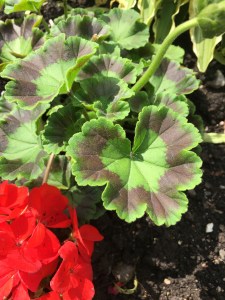



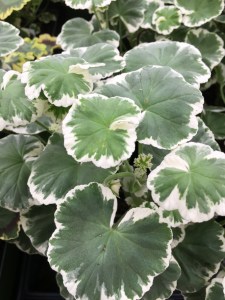
Seed Grown or Cutting-grown: most zonal geraniums are grown by cuttings, but some cultivars are grown by seed. Geranium from cuttings mature faster and their overall plant size and flower size tends to be larger with semi-double or double blooms. The seed grown cultivars can take 16 weeks to germinate and tend to be smaller plants with single but more abundant blooms; they also tend to be more disease and heat resistant.
A Few Zonal Geranium Cultivars and Hybrids and Their Uses in the Garden
- Americana Series are highly popular geraniums with large semi-double flowers and medium green ruffled foliage with a bronze zonal area. They grow to about 35-40cm (14-16″) tall and wide. Colours: Cherry Rose, Coral, Dark Red, Dark Salmon, Light Pink Splash, Orchid, Pink, Red, Rose Ice, Salmon, Violet Ice, White, White Splash. Landscape uses: bedding plants, medium sized containers, hanging baskets and window boxes.
- Tango Series are compact plants with semi-double blooms and dark green foliage growing to about 25-30cm (10-12″) tall and wide. Colours: Bi-colour Cherry, Dark Red, Deep Pink, Deep Rose w/Eye, Hot Pink, Lavender, Light Pink, Neon Purple, Orange, Orange Ice, Pink Ice, Rose Splash, Salmon, Strawberry Ice, Violet, White, White Splash. Landscape uses: bedding plants (front of borders), grow singly in smaller sized containers or grouped in medium sized containers, hanging baskets and window boxes.
- Moonlight Series are compact plants with semi-double blooms and dark green foliage. The grow to about 25-30cm (10-12″) tall and wide. Colours: Hot Coral, Orange, Pink, Light Pink+Big Eye, Pink+Big Eye, Raspberry Blush, Blue, Brilliant Red, Dark Fuchsia, Light Salmon, White, Lavender. Flowers are lightly scented. Landscape uses: bedding plants (front of borders), grow singly in smaller sized containers or grouped in medium sized containers, hanging baskets and window boxes.
- Presto™ are highly compact plants with semi-double blooms and dark green foliage. They grow to about 20-25cm (8-10″). Colours: Pink, Pink+Eye, Salmon, Brillant Red, Orange, Rose Flare, Violet, deep Scarlet, Dark Red, White and Pink Sizzle. Landscape uses: bedding plants (front of borders), grow singly in smaller sized containers or grouped in medium sized containers, hanging baskets and window boxes.
- Fantasi® are highly heat tolerant with large clusters of semi-double flowers and dark green scalloped leaves. They grow to about 30-35cm (12-14″) tall and wide. Colours: Purple Sizzle, Shocking Pink, Salmon, Pink Shell, Coral, Dark Red, Neon, Rose, Strawberry Sizzle, and Violet. Landscape uses: all-purpose bedding plants, medium sized containers, hanging baskets and window boxes.
- Daredevil® this is a larger sized geranium growing to about 45-60cm (18-24″). Colours: Claret, Fire, Mulberry, Orchid, Rosita, Salmon, and Snow. Landscape uses: specimen plants grown singly in a container or grouped in a monoculture, bedding plants grown further back in the garden bed, planted in the center of larger sized mixed containers, and in the back of large window boxes in mixed plantings.
- Rocky Mountain™ are another larger sized geranium with large semi-double flowers. 40-45cm (16-18″) tall. Colours: Dark Red, Deep Rose, Lavender, Light Pink, Magenta, Orange, Pink, Salmon, Violet, and White. Landscape uses: bedding plants for large annual displays or mid-way back in mixed borders, planted in the center of larger sized mixed containers or large hanging baskets and window boxes.
- Patriot™ a larger size vigorous geranium with large, slightly scented semi-double flowers. Plants grow to about 45x60cm (18×24″) tall and wide. Colours: Bright Pink, Bright red, Bright Violet, Cherry Rose, Orange, Salmon Chic, Soft Pink, Tickled Pink, and White. Landscape uses: bedding plants for large annual displays or mid-way back in mixed borders, planted in the center of larger sized mixed containers and at the back of mixed window boxes.
- Pillar Geraniums are the tallest zonal geraniums growing in a columnar shape about 90X30cm (36×12″) tall by wide. They can even reach heights of 120cm (4ft.) if trellised. Without support they will grow horizontally as a ground cover. Landscape uses: specimen plants grown singly in a container with support, bedding plants grown further back in the garden bed, planted in the center of larger sized mixed containers with support, and in the back of large window boxes supported.
Stellar Geranium (sub-group of Zonal Geranium)
Stellar geraniums are a sub-group of zonal geraniums characterized by their star shaped flowers and highly lobed leaves with serrated margins.
- Fireworks Series Geranium are compact plants about 35cm (14″) tall with star shaped flowers and lobed leaves with serrated margins. Colours include ‘Fireworks Bicolor’, Fireworks Pink, Fireworks red, Fireworks Red White and Fireworks White. Flowers are lightly scented.
- Quantum Mix Hybrid Geranium is a modern stellar geranium with star shaped flowers and lobed leaves with serrated edges. The plants measure about 30-40cm (12-16″) tall and wide. This hybrid is much sturdier than earlier stellar introductions and better blooming. Colours: Light Pink with darker veins, Pink, Dark Red, Salmon with a white tip on each petal. They are well suited to hot humid areas such as on patios and southern exposures. Landscape uses: bedding plants, hanging baskets, and medium sized containers.
Fancy Leaved Geranium (sub-group of Zonal Geranium)
Fancy Leaved Geranium are basically zonal geraniums that have beautiful markings on their leaves. This type of geranium is breed and grown predominantly for their leaf pattern. A few notable cultivars and hybrids to choose from include Pelargonium ‘Distinction’, Pelargonium ‘Mrs. Pollock’, Pelargonium ‘Annsbrook Faith’, Pelargonium ‘Cherry Cocktail’, Pelargonium ‘Cherry Sundae’, Pelargonium ‘Frank Headley, Pelargonium ‘Courtney Watson’, Pelargonium ‘Freak of Nature’, Pelargonium ‘Crystal Palace Gem’, Pelargonium ‘Indian Dunes’, Pelargonium ‘Jungle Leaf’, Pelargonium ‘Mr. Henry Cox’, Pelargonium Spotlight Hotline, Pelargonium Dolly Varden,
Ivy Leaved Geraniums
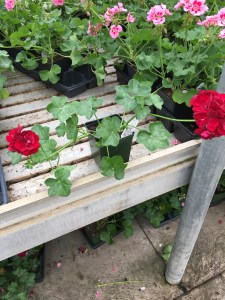
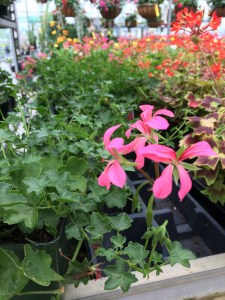
Ivy Leaved geranium (Pelargonium peltatum) have 5 lobed leaves that are thicker, smoother and shinier and resemble the leaves of English Ivy. Their growth habit, like ivy, is trailing rather than upright. The stems can grow up to 90cm (3′) long but are brittle and prone to breakage. The flowers have long stems and tend to be floppy and kind of wild looking but several varieties are self-cleaning like the Blizzard series and Alpine. There are about 75 varieties of ivy geraniums to choose from including Minicascades, Blizzards, and semi doubles. Landscape uses: they are best suited to hanging baskets and raised planters.
Interspecific Geraniums

Interspecific Geraniums are specially breed crosses between ivy geranium and zonal geranium. They have a cascading growth habit coupled with large colourful blooms. Each hybrid is unique and grows differently, depending on which plants were crossed. This group also tends to be more heat resistant and well suited to patios. 2 popular hybrid series in this group are Caliente® and Calliope®.
- Calliope® series geranium have large, semi-double blooms on 25-30cm (10-12″) tall plants that have a mounding to semi-trailing habit. They come in an array of colours including: Dark Red, Coral, Lavender, Lavender Mega Splash, Magenta, Orange Splash, Pink, Rose Mega Splash, Salmon, Scarlet Fire, Violet, White. Landscape uses: hanging baskets, containers, window boxes.
- Caliente® series geranium have large single flowers with good rain tolerance. They have a strong mounding habit growing to about 30-40cm (12-16″) tall. Colours include: Coral Salmon, Fire, Hot coral, Lavender, Magenta, Orange, White, Deep Red, Pink and Rose. Landscape uses: hanging baskets, containers, window boxes and bedding plants.
Scented-leaf Geraniums
Although many geranium have a mild citrusy fragrance this group of geraniums have highly fragrant leaves with many unique aromas. Some of those fragrances include: apple, apricot, strawberry, orange, lemon, lime, peppermint, ginger, cinnamon, chocolate mint, coconut, rose, eucalyptus, old spice, citronella, pine, balsam and others. The leaves appearance can be quite variable with some cultivars having roundish leaves while others are highly lobed, serrated and lacy looking. Some even have variegated leaves or blotches of burgundy. The flowers are single and smaller, typically in pinks and whites. Landscape uses: in containers near your seating area, as bedding plants near pathways where you will brush up against them or in conservatories.
Regal Geraniums aka Martha Washington Geraniums
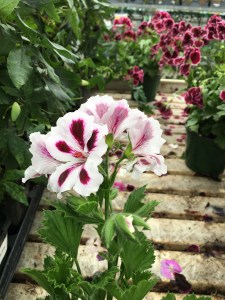



Regal geraniums (Pelargonium × domesticum) are a cross between Pelargonium grandiflorum and Pelargonium cucullatum. The cultivars and hybrids in this group have large spectacular trumpet-shaped flowers, often bi-coloured, with interesting markings on the petals like speckles, or blotches. They grow larger than many of the zonal geranium, growing up to 90cm (3′) on bushy plants with woodier stems. Regal geraniums are not heat lovers like many of the other pelargoniums. They prefer the cooler temperatures of spring and fall, flowering best when evening temperatures drop to 10-16 C (50-60 F). Landscape uses: outdoors they are well suited to containers that can be moved to cooler areas of the yard during summer or moved indoors, conservatories and seasonal bedding plants.
Angel Pelargoniums
Angel pelargoniums are usually a cross between Regal pelargoniums and pelargonium crispum. They are similar to Regals but the plants are smaller in size with smaller pansy like flowers borne in abundance and smaller fragrant leaves. Like the regals they also prefer cooler temperatures and require good air circulation around plants. Landscape uses: individually potted in containers and hanging baskets.
References:
Ball Flora Plant®, (n.d.). Presto™ Zonal Geranium. https://www.ballfloraplant.com/series_info.aspx?phid=028901184023074
Clemson University Cooperative Extension, (1999). Geranium. Factsheet | HGIC 1164. https://hgic.clemson.edu/factsheet/geranium/
Encyclopedia Britannica (Updated: Jun 1, 2023). geranium. https://www.britannica.com/plant/geranium-plant-genus-Geranium
Foggett C., (May 2022). Scented pelargoniums: how to grow & best varieties. The English Garden Magazine. https://www.theenglishgarden.co.uk/plants/scented-pelargoniums/
Fonteno W.C., (1992). Pelargonium Hortorum. Introduction to Floriculture (Second Edition), on line from Science Direct. https://www.sciencedirect.com/topics/agricultural-and-biological-sciences/pelargonium-hortorum
Gardens Illustrated, (n.d.). Angel pelargoniums: choosing and growing the best Angel pelargoniums. https://www.gardensillustrated.com/plants/choosing-and-growing-the-best-angel-pelargoniums/
Gardeners World, (n.d.). Pelargonium ‘Appleblossom Rosebud’. https://www.hortmag.com/weekly-tips/hybrid-geraniums-calliope-vs-caliente
Jayes P. (June 2022). Pelargoniums: Growing, propagating and top varieties. The English Garden Magazine. https://www.theenglishgarden.co.uk/plants/pelargoniums-growing-propagating-and-top-varieties/
Missouri Botanical Garden, (n.d.). Pelargonium (scented-leaved group). https://www.missouribotanicalgarden.org/PlantFinder/PlantFinderDetails.aspx?kempercode=a534
Missouri Botanical Garden, (n.d.). Pelargonium × domesticum. https://www.missouribotanicalgarden.org/PlantFinder/PlantFinderDetails.aspx?taxonid=263625&isprofile=0&
Monrovia, (n.d.). Fantasia® Zonal Geranium. https://www.monrovia.com/fantasia-174-zonal-geranium.html
Pelargonium Species World.com, (n.d.). Pelargonium Species. https://www.pelargoniumspeciesworld.com/page13.html
Proven Winners, (n.d.). Daredevil® Claret Zonal Geranium. https://www.provenwinners.com/plants/pelargonium/daredevil-claret-zonal-geranium-pelargonium-zonale
Rice G. (Dec. 2016). Stellar geraniums enjoy a revival. The Royal Horticultural Society. https://www.rhs.org.uk/plants/plants-blogs/plants/december/pelargonium-(geranium)-quantum-series
Royal Horticulture Society, (n.d.). Pelargonium zonale zonal geranium. https://www.rhs.org.uk/plants/12407/i-pelargonium-zonale-i/details
Royal Horticulture Society, (n.d.). Scented-leaf pelargoniums. https://www.rhs.org.uk/plants/pelargonium/scented-leaf
Taylor D., (n.d.). Pelargoniums. The Pelargonium & Geranium Society. https://thepags.org/pelargoniums/

